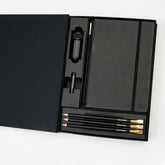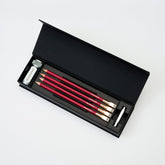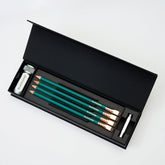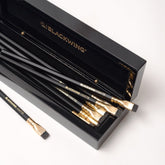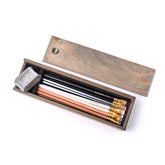A Conversation with Alembic, Legendary Custom Guitar Shop
A Conversation with Alembic
Alembic has been handcrafting high-end basses and guitars in the California Bay Area for over fifty years. As part of our recent Blackwing 710 campaign, we sat down with Mica Wickersham Thomas, General Manager, to learn about the company’s fascinating history and connections to Jerry Garcia.
Alembic started in 1969 when Ron and Susan Wickersham met at Pacific Recording Studio in San Mateo, California, where Ron was creating the first multi-track mixing console and Susan had been hired to paint a lighting controller At the time, Ron’s main job was design engineering at Ampex, with audio recording being a side interest. He eventually left to fully dedicate his efforts to the emerging field of multi-track recording.
Together, Ron and Susan formed Alembic and started working with the Grateful Dead, a band known for their interest in enhancing the quality of their sound. Alembic then relocated to Novato, where they shared office and rehearsal space with the Dead.

Ron Wickersham at his workbench with one of Phil Lesh’s basses–“Big Brown”– which Wickersham began modifying in 1969.
During this time, Alembic helped the Dead keep their gear in shape for both road and studio performances, specializing in electronics. Ron Wickersham even invented the now widely used active guitar electronics and installed them in Phil Lesh’s EB bass. Mica explained:
He thought he was just solving a problem for one person, but he ended up making active electronics a thing. So, if you ever need to put a battery in a guitar, you can thank my dad. He did it first.
Additionally, Alembic began to work on live recording, believing it to be the best way to capture the true essence and electricity of the music. Notable live recordings include the Grateful Dead’s Live/Dead and Europe 72 albums. Alembic was also hired to provide the sound system and record the soundtrack for the infamous 1969 Altamont concert, which was filmed by the Maysles Brothers and featured artists like The Rolling Stones, the Grateful Dead, and The Jefferson Airplane.
Alembic moved to San Francisco in 1970, continuing to focus on customizing guitars and refining their electronics package. Additionally, the company’s live recording and PA work became a significant part of their business during this period. Ron Wickersham also served as chief engineer for the Grateful Dead’s legendary Wall of Sound sound-system.

We asked Mica to explain how a guitar gets designed and built at Alembic:
Everything starts with a pencil here. And not just because I’m talking to Blackwing—it’s how we’ve always done it. When we design a custom shape, we’re gonna put pencil to paper. If we’re doing custom inlays, my mom and I always start with pencil on paper. Even when my mom is selecting where we actually place the templates for where we’re gonna cut out the top wood, she’s gonna mark that with a pencil.
We use machine tools and hand tools. We have band saws for cutting the wood out. We do all of our clamping by hand. We had a CNC
We use it to make the slots on the fingerboard for where the frets go, especially for making custom scale lengths. That machine, her name is Nancy. Everything is custom to her, she doesn’t know the difference between a standard and a custom fingerboard. But, each one is slotted precisely. So if somebody needs a 33-inch scale, we can make that and we don’t even charge extra for it because we set up our whole shop to believe that ‘custom is normal.

By 1971, Alembic had a state-of-the-art 16-track recording studio in San Francisco, a customizing business for guitars and PA equipment, and a small music store. The studio saw many famous artists such as Stephen Stills, Jerry Garcia, Santana, Gordon Lightfoot, Hot Tuna and even the San Francisco Symphony.
Throughout the 70s, Alembic continued to innovate and expand. In 1973, they began manufacturing a standard high-end instrument, marking the advent of an entirely new genre in instrument building. In 1974, they left San Francisco for Sonoma County. By 1976 electronics engineering and instrument production were consolidated in one facility in Cotati, CA. In 1976 they began producing the first graphite-neck basses and guitars, first played by John McVie, John Entwistle, and Stanley Clarke, who acquired his first Alembic bass in 1973.
As a custom shop, Alembic has always been attentive to the specific needs of its customers. The business has adapted over the years, but remains true to its original purpose:
Our purpose is to make finely-crafted tools for people who need them. As long as there are musicians who need to express their ideas, we’ll be building them guitars.
Follow Alembic on Instagram.




